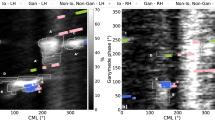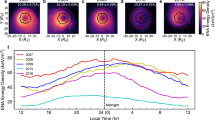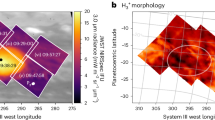Abstract
Several planetary missions have reported1,2,3,4 the presence of substantial numbers of energetic ions and electrons surrounding Jupiter; relativistic electrons are observable up to several astronomical units (au) from the planet. A population of energetic (>30 keV) neutral particles also has been reported5, but the instrumentation was not able to determine the mass or charge state of the particles, which were subsequently labelled6 energetic neutral atoms. Although images showing the presence of the trace element sodium were obtained7, the source and identity of the neutral atoms—and their overall significance relative to the loss of charged particles from Jupiter's magnetosphere—were unknown. Here we report the discovery by the Cassini spacecraft of a fast (>103 km s-1) and hot magnetospheric neutral wind extending more than 0.5 au from Jupiter, and the presence of energetic neutral atoms (both hot and cold) that have been accelerated by the electric field in the solar wind. We suggest that these atoms originate in volcanic gases from Io, undergo significant evolution through various electromagnetic interactions, escape Jupiter's magnetosphere and then populate the environment around the planet. Thus a ‘nebula’ is created that extends outwards over hundreds of jovian radii.
This is a preview of subscription content, access via your institution
Access options
Subscribe to this journal
Receive 51 print issues and online access
$199.00 per year
only $3.90 per issue
Buy this article
- Purchase on SpringerLink
- Instant access to full article PDF
Prices may be subject to local taxes which are calculated during checkout




Similar content being viewed by others
References
Teegarden, B. J. et al. Interplantary MeV electrons of Jovian origin. J. Geophys. Res. 79, 3615–3622 (1974).
Zwickl, R. D. et al. Energetic particle events (≥30 keV) of Jovian origin observed by Voyager 1 and 2 in interplanetary space. J. Geophys. Res. 86, 8125–8140 (1981).
Krimigis, S. M., Zwickl, R. D. & Baker, D. N. Energetic ions upstream of Jupiter's bow shock. J. Geophys. Res. 90, 3947–3960 (1985).
Haggerty, D. & Armstrong, T. P. Observations of Jovian upstream events by Ulysses. J. Geophys. Res. 104, 4629–4642 (1999).
Kirsch, E., Krimigis, S. M., Kohl, J. W. & Keath, E. P. Upper limits for X-ray and energetic neutral particle emission from Jupiter: Voyager-1 results. Geophys. Res. Lett. 8, 169–172 (1981).
Roelof, E. C., Mitchell, D. G. & Williams, D. J. Energetic neutral atoms (E ∼50 keV) from the ring current: IMP 7/8 and ISEE-1. J. Geophys. Res. 90, 10991–11008 (1985).
Mendillo, M., Baumgardner, J. & Flynn, B. Imaging observations of Jupiter's sodium magneto-nebula during the Ulysses encounter. Science 257, 1510–1512 (1992).
Krimigis, S. M. et al. Magnetospheric imaging instrument (MIMI) on the Cassini mission to Saturn/Titan. Space Sci. Rev. (in the press).
Mitchell, D. G. et al. The imaging neutral camera (INCA) for the NASA Cassini mission to Saturn and Titan, and possibilities for the future. Proc SPIE Int. Symp. Opt. Sci. Eng. Instrum.—Mission to the Sun 2803, 154–161 (1996).
Mauk, B. H., Krimigis, S. M., Mitchell, D. G. & Roelof, E. C. Energetic neutral atom imaging of Jupiter's magnetosphere using the Cassini MIMI instrument. Adv. Space Res. 21(11), 1483–1486 (1998).
Gloeckler, G, Geiss, J. & Fisk, L. A. in The Heliosphere Near Solar Minimum (eds Balogh, A., Marsden, R. G. & Smith, E. J.) 287–326 (Praxis, Chichester, 2001).
Barbosa, D. D. & Eviatar, A. Planetary fast neutral emission and effects in the solar wind: A cometary exosphere analog. Astrophys. J. 310, 927–936 (1986).
Krimigis, S. M. et al. Characteristics of hot plasma in the Jovian magnetosphere: Results from the Voyager spacecraft. J. Geophys. Res. 86, 8227–8257 (1981).
Luhmann, J. G. Oxygen in the heliosphere. J. Geophys. Res. 99, 13285–13305 (1994).
Acknowledgements
We thank many colleagues who contributed to the hardware effort for MIMI at the Applied Physics Laboratory of Johns Hopkins, the Department of Physics at the University of Maryland, the Max-Planck-Institut für Aeronomie (MPAe) and the Centre d'Etude Spatiale des Rayonnements (CESR) in Toulouse. We also thank S. J. Jaskulek, J. Hayes, M. Kusterer and B. Tossman for their contributions throughout the programme. This work was supported by NASA under contract with the Johns Hopkins University; by subcontracts at the University of Maryland, Kansas, and Arizona; and by Deutsches Zentrum für Luft und Raumfahrt (DLR) at MPAe and Centre National d'Etudes Spatiales (CNES) at CESR.
Author information
Authors and Affiliations
Corresponding author
Rights and permissions
About this article
Cite this article
Krimigis, S., Mitchell, D., Hamilton, D. et al. A nebula of gases from Io surrounding Jupiter. Nature 415, 994–996 (2002). https://doi.org/10.1038/415994a
Received:
Accepted:
Issue date:
DOI: https://doi.org/10.1038/415994a
This article is cited by
-
Towards a Global Unified Model of Europa’s Tenuous Atmosphere
Space Science Reviews (2018)
-
Exospheres and Atmospheric Escape
Space Science Reviews (2008)
-
Magnetosphere Imaging Instrument (MIMI) on the Cassini Mission to Saturn/Titan
Space Science Reviews (2004)
-
Energetic neutral atoms from a trans-Europa gas torus at Jupiter
Nature (2003)



